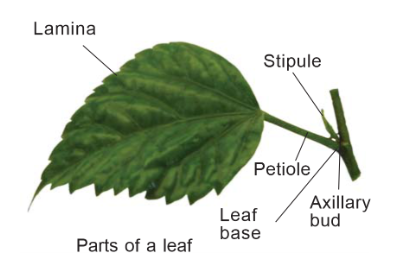Table of Contents
Introduction to Leaf
Leaves are among the most recognizable and essential parts of plants. They play a pivotal role in the process of photosynthesis, which is crucial to produce food and oxygen. This article explores the diverse morphology, types, and modifications of leaves, shedding light on their incredible versatility and significance in the plant kingdom.
Leaf Morphology and Development
Leaves are lateral structures that emerge from the stem at nodes.
They develop axillary buds in their axils, which can eventually grow into branches.
Originating from the shoot apical meristems, leaves are arranged in an acropetal sequence along the stem.
Leaves serve as the primary vegetative organs responsible for photosynthesis.
Components of a Typical Leaf
A typical leaf can be broken down into three main parts:

Leaf Base, Petiole, and Stipules:
The leaf base connects the leaf to the stem.
Stipules, small leaf-like structures, may be present on either side of the leaf base.
In monocotyledons, the leaf base can expand into a sheath partially or completely covering the stem.
Some leguminous plants feature a swollen leaf base known as the pulvinus, aiding in movement.
Petiole
The petiole is the stalk connecting the leaf blade to the stem.
It plays a crucial role in positioning the leaf for optimal light absorption.
Long, thin, and flexible petioles enable leaf blades to flutter in the wind, which cools the leaf surface and enhances gas exchange.
Leaf Lamina
The leaf lamina, also referred to as the leaf blade, is the expanded green portion of the leaf.
Veins and veinlets traverse the lamina, contributing to its structure and function.
A central prominent vein, the midrib, is typically present.
Veins provide rigidity to the leaf blade and act as conduits for water, minerals, and nutrients.
Also Check For:
Leaf Shape and Variation
Leaves come in diverse shapes, with variations in margin, apex, surface, and extent of incision.
These variations contribute to the unique characteristics of different plant species.
Importance of Leaves
Leaves are essential for plant survival due to their pivotal roles:
- Photosynthesis: Leaves are the primary sites of photosynthesis, where light energy is converted into chemical energy in the form of glucose.
- Gas Exchange: Leaves facilitate the exchange of gases, enabling respiration and transpiration.
- Nutrient Transport: Veins within leaves transport water, minerals, and nutrients throughout the plant.
- Adaptations: Leaf modifications, such as tendrils, spines, and storage structures, enable plants to adapt to various environments and functions.
Types of Leaves
Leaves are classified in simple leaves and compound leaves.
Simple Leaves
A leaf is deemed “simple” when its lamina, the expanded leaf surface, is either entirely intact or incised in a way that the incisions don’t extend to touch the midrib—the central vein that runs through the leaf. In the case of simple leaves, a bud is nestled within the axil of the petiole.
Compound Leaves
The classification shifts when a leaf displays greater complexity. In a “compound” leaf, the incisions of the lamina extend to the midrib, breaking it into multiple leaflets. In the case of compound leaves, this bud does not appear in the axil of individual leaflets. Compound leaves can further be classified in pinnately compound leaves and palmately compound leaves.
Pinnately Compound Leaves
Pinnately compound leaves feature multiple leaflets arrayed along a shared axis called the rachis. This structure is exemplified in leaves such as the neem. The leaflets emerge from the rachis, creating a visually striking arrangement.
Palmately Compound Leaves
Conversely, palmately compound leaves present a different arrangement. Here, the leaflets radiate from a common point—the tip of the petiole—resembling the fingers of a hand. A prime example is the silk cotton tree, where leaflets converge gracefully at the end of the petiole.
Leaf Modification
Leaves can undergo modifications to fulfil functions beyond photosynthesis. These modifications include:
- Tendrils: Some leaves are modified into slender, coiling structures that help the plant climb and support itself. Leaf tendrils are seen in pea.
- Spines: In some arid environments, leaves are modified into sharp spines that deter herbivores and reduce water loss. Spines are observed in Cactus.
- Storage Leaves: Leaves can store water or nutrients in their tissues, helping plants survive in challenging conditions. Onion has storage leaves.
- Phyllode: In the case of Australian acacia, the leaves are diminutive and transient. However, the petioles undergo expansion, gaining a green hue and the ability to synthesize food.
- Modification of leaves in insectivorous plants: In certain plants, like the pitcher plant and the venus-fly trap, leaves evolve to capture and digest insects, replenishing the plant’s nutrient requirements in nutrient-deficient environments.
Frequently Asked Questions (FAQs) on Leaf
What is the main function of leaves?
The main function of leaves is photosynthesis, where they capture sunlight and convert it into energy-rich compounds, primarily glucose, while releasing oxygen as a byproduct.
What are the basic parts of a typical leaf?
A typical leaf consists of three main parts: the blade (lamina), the petiole (stalk), and stipules (small leaf-like structures at the base of the petiole).
How do leaves obtain water and nutrients?
Leaves obtain water and nutrients through vascular tissues, specifically the xylem for water transport and the phloem for nutrient transport.
What are the different types of leaf arrangements on stems?
Leaf arrangements include alternate, opposite, whorled, and spiral. These patterns determine the position and distribution of leaves along the stem.
Can leaves be modified for purposes other than photosynthesis?
Yes, leaves can undergo various modifications to fulfil functions such as climbing, defence, storage, and attracting pollinators. These modifications enhance the adaptability of plants to their environments.





